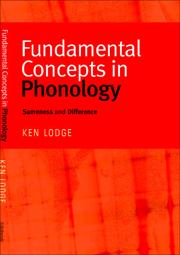Book contents
6 - Declarative Phonology: an alternative set of proposals
Published online by Cambridge University Press: 05 August 2013
Summary
There is no time in structure, there is no sequence in structure; time and sequence are with reference to the utterance, order and place are with reference to structure …
(Carnochan, Gemination in Hausa)This chapter presents a set of proposals to take account of the views laid out in the previous chapters. As such, it does not deal with sameness and difference directly, but deals with the relationship between meaning and sound, that is, between phonological storage and phonetic realization. If the points of view taken in earlier chapters hold good, then we need to consider the details of this relationship in the context of a polysystemic, non-segmental, abstract approach of the kind presented in Lodge (2003a, 2007).
Derivation
Whether or not we decide on a monosystemic or a polysystemic approach, segments or layers of prosodic features, binary or unary features, there is a matter which cuts across all these alternatives, the matter of whether or not we allow processes to apply to our preferred representations, thereby altering the phonological input in some way to achieve a representation of the output. (The issue of whether the output of grammars is actual speech or not has been addressed in Chapter 5.)
- Type
- Chapter
- Information
- Fundamental Concepts in PhonologySameness and Difference, pp. 94 - 119Publisher: Edinburgh University PressPrint publication year: 2009



